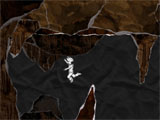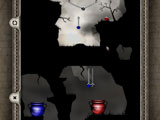Beautiful, Frustrating Puzzle Physics
Obulis is the first PC release from IonFx, a longtime Pocket PC developer. It’s actually the third installment in the series, with the first two titles out on Windows Mobile. Obulis is a puzzle game in the truest, hardcore sense of the word. I hope you like thinking!
Simple Rules
The goal in Obulis is to get the colored balls to their matching pots. To do this, you need to manipulate their physical motion. You can only do this in one way, by cutting rope. You can snip any of the ropes in the game, which usually hold the balls up, but also act as a way to time the release of launchers. The controls allow you to select and destroy rope as separate actions, which helps with difficult timing (although, annoying, if you use right-click to cut a rope you still have to select it first–it should be one click).
Inelastic Physics
The physics engine in Obulis is wholly inelastic, which support many of the puzzle designs. When a ball rolls into another ball, it comes to a complete stop, with the second ball taking on all of its velocity. There is only so much potential energy in each level, so you’ll find yourself re-routing energy through multiple balls. Visualizing the total remaining energy will be key to solving the puzzles.
Cleverness, Timing
My big complaint with true puzzle games is the nature of complexity. In order for a puzzle game to become more difficult, the designer needs to do some really clever stuff. In my mind, the fun of the game should boil down to the player re-discovering the clever solution for themselves. But sometimes it just feels like the level designer is showcasing their cleverness without any consideration for the player. Personally I would enjoy more levels with open-ended setups, where I can fudge the solution (Armadillo Run does this fantastically). Obulis has a much tighter possibility space; most levels must be solved exactly as the designer intended.
The other complaint I have with Obulis is the nature of the timing involved to get the physics right. It’s very annoying to have a realization about what you’re supposed to do, and then have to beat your head against the wall to get the timing correct. Watch the end of the gameplay video for an example of this in action.
Puzzle Gamers Rejoice!
I’m willing to admit that I just don’t have the right state of mind to enjoy a puzzle game like Obulis. The production value is fantastic, and many of the levels are a joy to play, but it’s also an amazing frustration generator. If you have the stomach for that kind of thing, or feel some strange pressure to prove yourself to game designers, then Obulis is very definitely the game for you.
Download Obulis Demo (33.5 MB)
Or visit the Obulis website for more information. The full version costs $19.99 USD.
Related Posts:
Undercooked but Great as an Appetizer
Soup du Jour is a small physics game from Digital Eel, an independent developer best known for their Infinite Space games. It’s worth mentioning that, although it’s not a physics game, Weird Worlds: Return to Infinite Space is a fantastic experience. I highly recommend it. So how does their foray into physics-based gameplay fare? Unfortunately, not as well…
Goals and Controls
Let’s start with the basics: You play Soup du Jour by clicking and dragging on springy physics objects to make matches. This becomes difficult as pieces spawn more quickly, get in the way of each other, and become more chaotic. It’s difficult to make a game about fast/accurate mouse movement. It tends to be a frustrating experience, and Soup du Jour is no exception. I crave some kind of stylus input.
Harsh Pacing
Soup du Jour starts off well. You make a few matches, push some of the ingredients around, and get a sense than you’re interacting in a highly physical environment. But it soon becomes very, very difficult. It’s like all of the thought put into design was brainstorming how to make things more difficult. And they’ve certainly succeeded. A slew of challenges await you: Large pieces, bombs, missiles, and more colors. You’re punished when pieces fall over the edge; a single bomb could knock half of your ingredients out if you aren’t careful.
My personal preference would have been to focus on variation, but along other axes besides difficult. What variations would make the game easier? Or simply different? In the current play experience all of the variations add difficultly, and the variations come pretty quickly and don’t let up. Before too long your defeat is inevitable and it just doesn’t feel very fun. A pacing that oscillated up and down would be more enjoyable. There are very few times where you feel on the brink of reversible defeat. It’s relentless.


(Soup du Jour Game Screenshots)
Worth the $10?
Soup du Jour is priced at a modest $10, which isn’t a bad value for a short play experience. For me, though, it’s a play experience I don’t really want to repeat. It isn’t the kind of game I can enjoy in short bursts. Highly competitive players may enjoy maximizing their score, but personally I’d rather enjoy something a little longer and more forgiving. There’s a free demo, though, so you be the judge!
Download Soup du Jour Demo (5.2 MB)
Or visit the Soup du Jour website for more information. The full version costs $10 USD.
Related Posts:
A World Where Up Has No Meaning
And Yet It Moves… is a conceptual game that won the 2007 Independent Games Festival Student Showcase. The first thing you’ll notice is the torn photo art, which is a fantastic way to pretty up the world without having to dedicate serious man-hours to artwork. Unfortunately the look might be my favorite part of the game. There are a lot of good ideas here, but it is quite apparent that it’s still a student project.
Wasted Potential
You’ve got a basic side-scroller with a twist: You can rotate the world around the main character at any moment in the game. Each level is a series of physics puzzles all about manipulating the world’s orientation. Great, but that’s all we really see.
Don’t get me wrong, each new obstacle demonstrates a creative reason to spin, but figuring out that reason in puzzle after puzzle is the entire game. There is no room for experimentation or play with the environment or physics. You never look at a puzzle, know the answer and also think “Oh, this will be fun to try.” Instead your thoughts are “If this takes longer than 60 seconds, it ain’t worth it.”
Crushed, Burned, and Mudered by a Swarm of Bees
There are many ways to die in And Yet It Moves and if you play it, you will surely discover them all for yourself. That’s because each puzzle is incredibly frustrating. They’re not hard to figure out; they’re tough because your little paper man is so easy to kill. He can’t fall more than 15 feet, never seems to get out of the way of boulders and if his hair catches on fire he explodes into pieces. In fact, the game would be much more interesting if you could just fall farther without dying. I kept hoping that sooner or later I’d have to spin the world to complete a clever aerial maneuver or just tip the ground down to fall to my destination instead of running. Well, go ahead and try it. You won’t get far before you’re all splattered on the bedrock.
Chemistry Games?
There is one puzzle that really caught my eye. Your path is blocked by a beehive so you bash two pieces of flint together to light a brush fire. The fire starts far from the nest, but heat rises. You must spread the fire by rotating the world, placing the next fuel source above the flame’s location. Eventually, a long wick of bushes has been burned through and the bees have been smoked out.
I appreciate that these guys managed to use fire as physical fire, not just “hurtful object D.” The idea of it takes physics simulation to another level, more like chemistry simulation. It is a kind of creative attention to detail that too many games lack.


(And Yet It Moves… Game Screenshots)
Worth Checking Out
The guys behind And Yet It Moves are obviously talented, but the game itself is lacking. Every aspect of design seems oversimplified, as if it is still in a development stage and the designers have not yet grasped the game’s possibilities. And Yet It Moves is a great place to start, but they’ll need to be more bold with their next project.
Download And Yet It Moves (12.9 MB Windows, 19.9 MB Mac OS)
Related Posts:
- Slow-Mo Stick Figure Fighting
- Turn-Based Pool Meets Rock-Paper-Scissors
- List of Physics Games
- Amazing Physically-Driven Fighting Game
- Physics in Casual Games, Caramba Deluxe



 (Rate this game! 43 votes, average: 3.49 out of 5)
(Rate this game! 43 votes, average: 3.49 out of 5)

 My name is Matthew Wegner, and this site is dedicated to physics games.
My name is Matthew Wegner, and this site is dedicated to physics games.